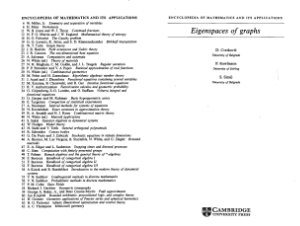Издательство Cambridge University Press, 1997, -136 pp.
The foundations of spectral graph theory were laid in the fifties and sixties, as a result of the work of a considerable number of mathematicians. Most of the early results are, like this book, conceed with the relation between spectral and structural properties of a graph. The investigation of such a relationship was proposed explicitly by Sachs and Hoffman, although in effect it had already been initiated in an earlier article by Collate and Sinogowitz . This seminal paper appeared in 1957, but our bibliography contains two references prior to this date: the unpublished thesis of Wei from 1952, and a summary (also unpublished) of a 1956 paper by Lihtenbaum communicated at the 3rd Congress of Mathematicians of the U.S.S.R.
Another origin of the theory of graph spectra lies beyond mathematics. In quantum chemistry, an approximative treatment of non-saturated hydrocarbons introduced by E. Hiickel yields a graph-theoretical model of the corresponding molecules in which eigenvalues of graphs represent the energy levels of certain electrons. The connection between Hiickel's model of 1931 and the mathematical theory of graph spectra was recognized many years later, and thereafter exploited extensively by many authors, both chemists and mathematicians.
In his thesis, Cvetkovic identified 83 papers dealing with eigenvalues of graphs which had appeared before 1970. Ten years later, almost all of the results related to the theory of graph spectra published before 1978 were summarized in the monograph Spectra of Graphs by Cvetkovic, Doob and Sachs [CvDS], a book which is almost entirely self-contained; only a little familiarity with graph theory and matrix theory is assumed. Its bibliography contains 564 items, most of which were published between 1960 and 1978. It was supplemented in 1988 by Recent Results in the Theory of Graph Spectra by Cvetkovic, Doob, Gutman and Torgasev. This reviews the results in spectral graph theory from the period 1978-1984, and provides over 700 further references from the mathematical and chemical literature. There are additional references from areas such as physics, mechanical engineer- engineering, geography and the social sciences. Although many papers contain only minor results, and some present rediscoveries of known results, the large number of references indicates the rapid rate of growth of spectral graph theory. The third edition of Spectra of Graphs, published in 1995, contains an appendix which describes recent developments in the subject.
This book deals with eigenspaces of graphs, and although one cannot speak about eigenvectors without mentioning eigenvalues, or vice versa, the emphasis is on those parts of spectral theory where the structure of eigenspaces is a dominant feature, thus complementing the 'eigenvalue part of the theory' described in Spectra of Graphs. For the most part, the eigenspaces considered are those of a (0,1)-adjacency matrix of a finite undirected graph.
A background in graph spectra.
Eigenvectors of graphs.
Eigenvector techniques.
Graph angles.
Angle techniques.
Graph perturbations.
Star partitions.
Canonical star bases.
Miscellaneous results.
The foundations of spectral graph theory were laid in the fifties and sixties, as a result of the work of a considerable number of mathematicians. Most of the early results are, like this book, conceed with the relation between spectral and structural properties of a graph. The investigation of such a relationship was proposed explicitly by Sachs and Hoffman, although in effect it had already been initiated in an earlier article by Collate and Sinogowitz . This seminal paper appeared in 1957, but our bibliography contains two references prior to this date: the unpublished thesis of Wei from 1952, and a summary (also unpublished) of a 1956 paper by Lihtenbaum communicated at the 3rd Congress of Mathematicians of the U.S.S.R.
Another origin of the theory of graph spectra lies beyond mathematics. In quantum chemistry, an approximative treatment of non-saturated hydrocarbons introduced by E. Hiickel yields a graph-theoretical model of the corresponding molecules in which eigenvalues of graphs represent the energy levels of certain electrons. The connection between Hiickel's model of 1931 and the mathematical theory of graph spectra was recognized many years later, and thereafter exploited extensively by many authors, both chemists and mathematicians.
In his thesis, Cvetkovic identified 83 papers dealing with eigenvalues of graphs which had appeared before 1970. Ten years later, almost all of the results related to the theory of graph spectra published before 1978 were summarized in the monograph Spectra of Graphs by Cvetkovic, Doob and Sachs [CvDS], a book which is almost entirely self-contained; only a little familiarity with graph theory and matrix theory is assumed. Its bibliography contains 564 items, most of which were published between 1960 and 1978. It was supplemented in 1988 by Recent Results in the Theory of Graph Spectra by Cvetkovic, Doob, Gutman and Torgasev. This reviews the results in spectral graph theory from the period 1978-1984, and provides over 700 further references from the mathematical and chemical literature. There are additional references from areas such as physics, mechanical engineer- engineering, geography and the social sciences. Although many papers contain only minor results, and some present rediscoveries of known results, the large number of references indicates the rapid rate of growth of spectral graph theory. The third edition of Spectra of Graphs, published in 1995, contains an appendix which describes recent developments in the subject.
This book deals with eigenspaces of graphs, and although one cannot speak about eigenvectors without mentioning eigenvalues, or vice versa, the emphasis is on those parts of spectral theory where the structure of eigenspaces is a dominant feature, thus complementing the 'eigenvalue part of the theory' described in Spectra of Graphs. For the most part, the eigenspaces considered are those of a (0,1)-adjacency matrix of a finite undirected graph.
A background in graph spectra.
Eigenvectors of graphs.
Eigenvector techniques.
Graph angles.
Angle techniques.
Graph perturbations.
Star partitions.
Canonical star bases.
Miscellaneous results.

